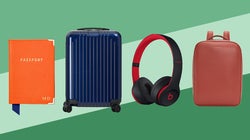
Packing for a holiday or unpacking when you get home: it’s hard to pick which is less enjoyable. Even buying the right suitcase can feel like an ordeal with so many luggage brands on the market and at some drastically different prices.
To get straight on the case, we’ve gone to the experts to find out if it’s worth splurging on a case or bagging a bargain, what size suits all airline luggage policies and which is ultimately better: a hard case or a soft one?
Let’s not get carried away – but here some useful tips, whatever your trip.
Is it worth spending more?
Buying new luggage can set you back a pretty penny but how much of that cost is paying for a brand name – and are there decent bargains to be had?
Olivia Pink, travel buyer for John Lewis, says you will spend more for quality and durability – the casing, zips and fastenings, for example – but also any added features to make your travelling experience more efficient. “Our more premium suitcases offer more durability in materials like aluminium as well as additional features such as being lightweight, having extra pockets, wet bags, USB charging, tamper-free zips and 360 degree wheels,” says Pink.
Since the arrival of budget air travel, luggage now gets bashed about far more than it ever did, warns Elizabeth Rhodes, brand representative for Antler – no matter how carefully you look after it yourself. “It’s completely out of your control what happens to your suitcase once you’ve checked it in at the airport, so it’s definitely worth having good quality cases,” she says.
Another thing to bear in mind is weight, adds Rhodes, who advises people not to be fooled into thinking a lightweight case is automatically lower quality. “Done in the right way, impressive engineering can go into crafting a suitcase that’s both seriously robust but also lightweight, and that’s important if you’re not an A-lister with people to carry it for you!”
What size should you buy?
In an ideal world, there would be a universal size allowance of carry-on and hold luggage on all airlines. But each airline can vary by as little as 1cm in length or width, says Rhodes – “so it’s important to check every time you fly.”
On some luggage websites – including Antler’s – you can search by luggage type and airline to shop only the bags that fit that airline’s requirement. “Look out for weight restrictions,” she reminds us. “With some airlines, it’s not just about size. You need to be careful how much you pack inside your bag too.”
If you don’t like to parted with your hand-luggage on the plane, Rhodes recommends a travel bag or holdall as opposed to a traditional wheelie suitcase, especially on lower cost airlines who tend to be stricter.
“They’re a lot easier to fit in the overhead lockers, or under the seat in front of you. You’re also less likely to be asked to put it in the hold at the last minute.”
What’s better: a hard or soft case?
Go hard or go home – or softly does it? Put simply, it depends what you’re after, says Pink at John Lewis. “Soft suitcases are more likely to be expandable and have external pockets, and can be easier to store. Hard are more tamper-proof and tend to be fashion-led, with more patterns and colours on the market.”
If you’re travelling on a short-haul flight, a soft case might work better for you says Amelia Sanders, Samsonite marketing manager. “If you prefer to travel with just a cabin case and not an additional bag or backpack, a soft case is perfect as they often include a front pocket which is perfect for storing, passports, documents and money which need to be quickly available during the trip.”
As for what materials hold up the best in transit and ensure longevity in your suitcase, Rhodes tells HuffPost to look out for polypropylene in hard luggage as it’s strong but lightweight and comes in a wider variety of colours and prints, if you’re looking for something statement (or easy to spot on the baggage belt). It’s also worth checking and keeping the guarantee – many brands offer them.
“For soft-sided, a robust and water-resistant nylon suitcase will stand the test of time,” says Rhodes, adding that external pockets are easier to build into these materials. Soft cases are usually lighter, too, which leaves more of your weight allowance free for your belongings rather than the baggage itself.
What kind of trip are you taking?
Best for a beach holiday:
A beach holiday will usually require a bigger case: think towels, sunscreen, snorkel and all those trappings. “A cabin case is potentially too small for a week long trip, unless you’re good at packing lightly,” says Sanders, who advises a larger wheelie – hard or soft – that glides you from airport to hotel with ease.
Best for a city break:
Chances are you’ll be time poor as you try to squeeze in all the sights, so going big is a no-no. “You’ll want to have a case that’s super easy to roll, as you’re likely to be going from airport to old town cobbles or winding streets and back again. Look out for a case with double spinner, 360-degree rotating wheels as they’re the best on the market and make getting around easier,” says Rhodes.
Best for backpacking:
“If you’re moving around regularly then a case that is lightweight, and has plenty of handles, will serve you well, so you won’t end up stuck in Zanzibar with a split zip and no idea how to get all your stuff home,” Rhodes says. Go soft – and look for a bag that zips along its length, not just at the top, to save you from pulling out every last one of your belongings just to reach your shower gel.
We all work hard to earn our money – so it shouldn’t feel like hard work to spend it well. At HuffPost Finds we’ll help you find the best stuff that deserves your cash, from the ultimate lipstick to a durable iron to replace the one that broke (RIP). All our choices are completely independent but we may earn a small commission if you click a link and make a purchase.






